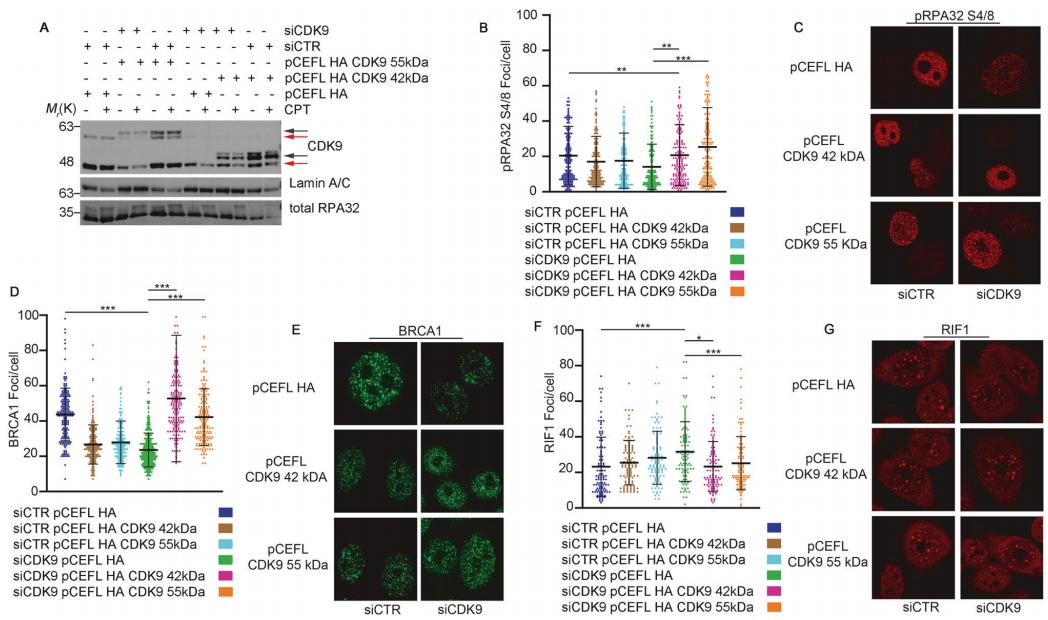DNA double-strand breaks (DSBs) lead to genomic instability and are a key feature of cancer development. DSBs are mainly repaired through homologous recombination (HR) and non-homologous end joining (NHEJ).
Recently, in a research report titled "CDK9-55 guides the anaphase-promoting complex/cyclosome (APC/C) in choosing the DNA repair pathway choice" published in the international magazine Oncogene, Scientists from the University of Siena in Italy and other institutions have described through research the key role of cyclin-dependent kinase 9 (CDK9) in regulating DNA repair during cell division. It becomes the origin of cancerous tumor growth when errors occur during cell division, through a process called phosphorylation. The researchers conducted experiments to simulate the interactions between CDK9 and other proteins and genes involved in cell division and cancerous tumor growth.
| Cat.No. | Product Name | Price |
|---|---|---|
| CSC-DC002883 | Panoply™ Human CDK9 Knockdown Stable Cell Line | Inquiry |
| CSC-SC002883 | Panoply™ Human CDK9 Over-expressing Stable Cell Line | Inquiry |
| AD00080Z | Human CDK9 adenoviral particles | Inquiry |
| AD03481Z | Human CDK9 adenoviral particles | Inquiry |
| CDFR001713 | Rat Cdk9 cDNA Clone(NM_001007743.1) | Inquiry |
| MiUTR1H-01993 | CDK9 miRNA 3'UTR clone | Inquiry |
| MiUTR1M-02872 | CDK9 miRNA 3'UTR clone | Inquiry |
| MiUTR1R-00910 | CDK9 miRNA 3'UTR clone | Inquiry |
In the article, researchers used CRISPR/Cas9 technology to generate Hela cervical cancer experimental cell lines, which do not express the 55kDa molecular weight isoform (CDK9-55KO). CDK9 was first discovered by researcher Giordano in 1994. It is a multifunctional protein kinase whose expression is strongly altered in tumors. The researchers describe the role of the CDK9-55kDa isoform in the DNA damage response, one of the major cellular mechanisms that can be modulated in cancer therapy.

Figure 1. CDK9 isoforms regulate DNA damage response. (Alfano L, et al., 2024)
In the first analysis, the researchers revealed how the loss of the CDK9-55 protein negatively affects the repair mechanism of homologous recombination, an important process that avoids mutations in DNA sequences. In particular, the researchers conducted an experiment using a phosphoproteomic screen to reveal protein substrates regulated by CDK9. The results observed how CDK9 interacts with cell division cycle 23 (CDC23). CDC23 is a subunit of the multi-protein complex Anaphase Promoting Complex Cyclosome (APC/C), which is mainly involved in the protein degradation process of many oncogenes and tumor suppressors, thus leading to cancer progression.
In addition, the researchers also revealed how CDK9 kinase phosphorylated the serine 588 site on CDC23. Serine is the primary phosphorylated amino acid of the CDC23 protein found in many tumors. Researcher Alfano said that this discovery may help us further understand how cells choose which repair mechanism, thereby conducive to the preservation of genetic information and reducing the occurrence and occurrence of cancer-prone mutations.
Finally, the researchers said that revealing the key role played by CDK9 may pave the way for the development of a new generation of pharmacological inhibitors, which may enhance their anti-tumor effects whether as monotherapy or in combination with other drugs.
Reference
Alfano L, et al. CDK9-55 guides the anaphase-promoting complex/cyclosome (APC/C) in choosing the DNA repair pathway choice. Oncogene, 2024: 1-11.

